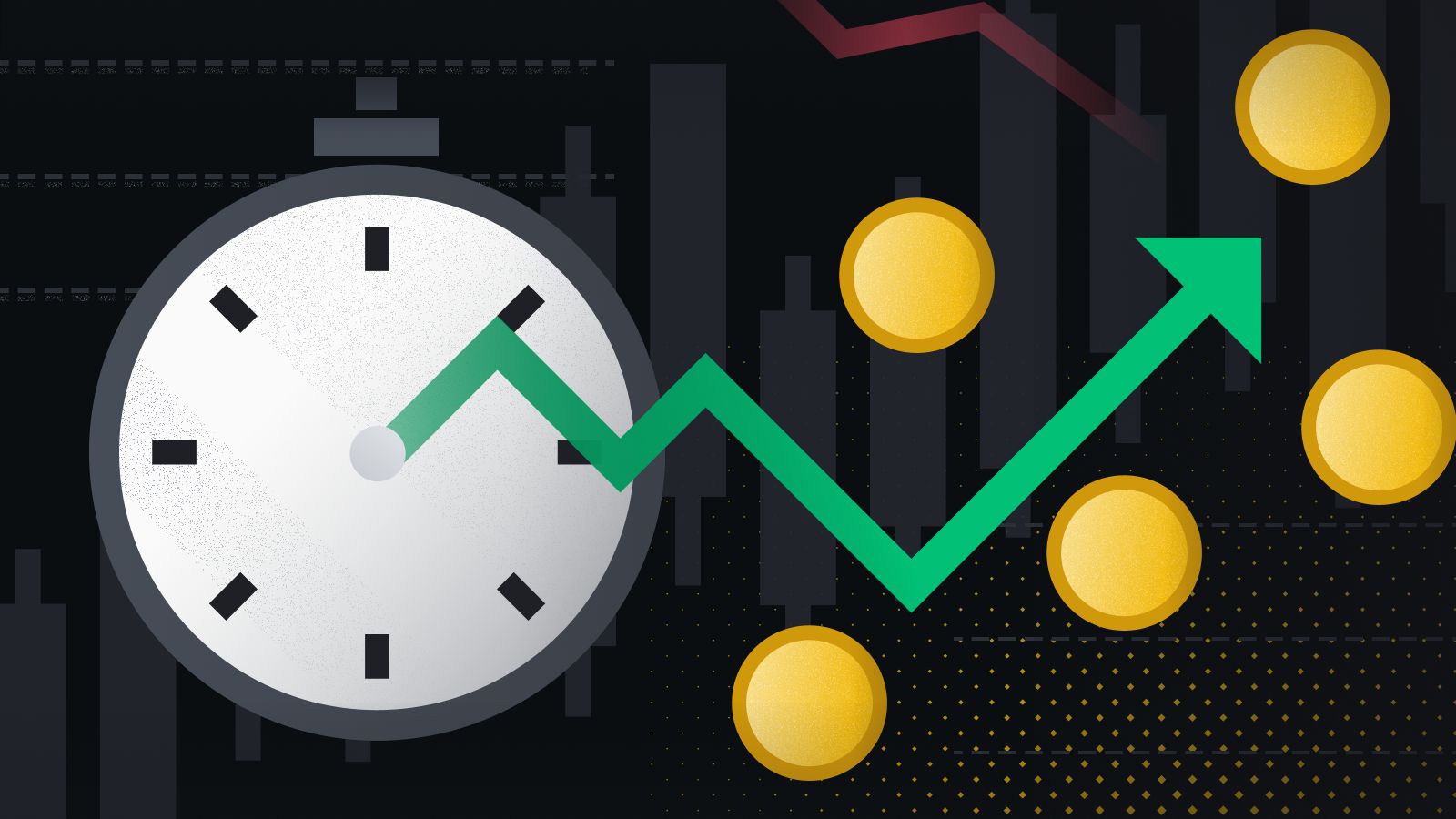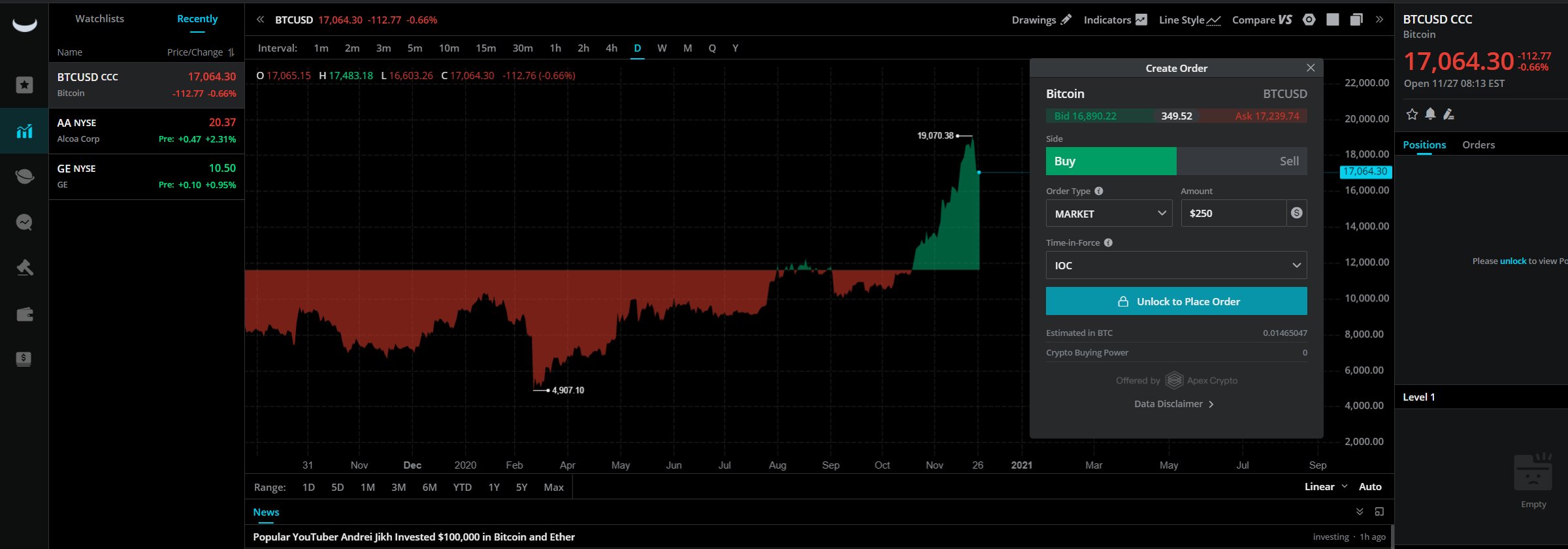Introduction
Welcome to the world of day trading crypto, where the potential to make money in the fast-paced and volatile cryptocurrency market awaits. Day trading, as the name suggests, involves buying and selling cryptocurrencies within a single day in an attempt to profit from short-term price fluctuations. With the rapid growth and popularity of cryptocurrencies, day trading has emerged as a lucrative way to make money online.
Unlike traditional financial markets, the cryptocurrency market operates 24/7, providing ample opportunities for traders to capitalize on price movements. Cryptocurrencies such as Bitcoin, Ethereum, and Ripple have seen tremendous gains and fluctuations, attracting traders who are eager to take advantage of this digital revolution.
So why choose crypto for day trading? Firstly, cryptocurrencies offer high liquidity, making it easier to enter and exit trades swiftly. Additionally, the cryptocurrency market is highly volatile, which means prices can experience significant fluctuations in short periods of time. This volatility opens up opportunities for day traders to profit from both upward and downward price movements. Lastly, the low barriers to entry in the cryptocurrency market make it accessible to traders of all levels, allowing individuals to start small and learn as they go.
However, day trading crypto is not without risks. The market is unpredictable and can be influenced by various factors such as regulatory changes, industry news, and market sentiment. Successful day trading requires a combination of technical analysis skills, risk management techniques, and emotional discipline.
In this guide, we will dive into the world of day trading crypto, exploring the key steps and strategies you need to know to start making money in this exciting market. From choosing the right exchange to developing a trading strategy and managing risk, we will equip you with the knowledge and tools you need to thrive as a day trader in the crypto space.
What is Day Trading?
Day trading is a trading strategy that involves buying and selling financial assets within the same trading day, aiming to profit from short-term price movements. In the context of cryptocurrencies, day trading involves buying and selling digital currencies such as Bitcoin, Ethereum, or Litecoin with the intention of making profits within a single day.
The primary goal of day trading is to take advantage of volatility in the market. Cryptocurrencies are known for their price fluctuations, and day traders seek to capitalize on these price movements to generate profits. Day traders analyze price charts, patterns, and market indicators to identify short-term trading opportunities.
Unlike long-term investors who hold assets for a more extended period, day traders do not have a long-term investment horizon. Their focus is on executing trades quickly and frequently, often taking advantage of small price movements that may occur within minutes or hours.
Day trading requires a disciplined approach and the ability to make quick decisions based on technical analysis and market conditions. Traders use various strategies, including scalping, momentum trading, and breakout trading, to make profits in the crypto market.
It’s important to note that day trading can be mentally and emotionally demanding. Traders need to stay focused, manage their emotions, and adhere to strict risk management rules. The market can be highly volatile, and losses can occur as quickly as gains, making it crucial for day traders to have a well-thought-out trading plan.
Furthermore, day trading requires continuous learning and staying updated with the latest market trends and news. Successful day traders constantly refine their strategies, analyze their trades, and adapt to changing market conditions.
While day trading can be profitable, it is not without risks. The volatile nature of cryptocurrencies can result in significant gains or losses in a short period. Therefore, it’s essential to approach day trading with a clear understanding of the risks involved.
In the next sections, we will explore the steps to get started with day trading crypto, including selecting the right exchange, understanding crypto volatility, developing a trading strategy, and effectively managing risk.
Why Choose Crypto?
When it comes to day trading, there are numerous financial markets to choose from, including stocks, forex, commodities, and cryptocurrencies. So, why should you choose crypto for your day trading endeavors?
One of the key reasons is the unprecedented growth and potential of the cryptocurrency market. Cryptocurrencies have gained immense popularity and have become a global phenomenon. Bitcoin, the first and most well-known cryptocurrency, reached new heights in terms of its value and market cap, sparking widespread attention.
The cryptocurrency market operates 24/7, providing day traders with ample opportunities to enter and exit trades at any time of the day or night. Unlike traditional financial markets that have limited operating hours, the cryptocurrency market allows for seamless trading without any time constraints. This flexibility allows traders from all around the world to participate, regardless of their time zone.
Cryptocurrencies are also highly liquid, meaning there is a significant amount of trading activity and a large number of buyers and sellers in the market. This liquidity ensures that you can easily buy or sell your cryptocurrencies without facing price slippage or delays. It enables you to enter and exit trades swiftly, which is essential for day trading, where timing is crucial.
Furthermore, the cryptocurrency market is known for its volatility. Prices of cryptocurrencies can experience substantial fluctuations, offering plenty of opportunities for day traders to profit from both upward and downward price movements. Volatility in the crypto market allows traders to capitalize on short-term price swings and potentially generate significant returns on their trades.
Another advantage of day trading crypto is the low barriers to entry. In comparison to traditional markets, where substantial amounts of capital are often required to start trading, the cryptocurrency market allows for smaller investments. You can start day trading crypto with a relatively small amount of money, allowing individuals with limited capital to participate in this potentially lucrative market.
Additionally, the cryptocurrency market is highly accessible. You can easily create an account on a cryptocurrency exchange, deposit funds, and start trading within a short period. The process is straightforward, making it easier for beginners to enter the market and learn the ins and outs of day trading crypto.
While day trading crypto offers numerous opportunities, it’s essential to approach it with caution. The highly volatile nature of cryptocurrencies means that prices can change rapidly, and losses can occur just as quickly as gains. It’s crucial to have a well-defined trading strategy, manage your risk effectively, and continuously educate yourself about the market.
In the following sections, we will delve into the details of getting started with day trading crypto, including selecting the right exchange, understanding crypto volatility, developing a trading strategy, and managing risk effectively.
Getting Started with Day Trading Crypto
If you’re ready to dive into the exciting world of day trading crypto, there are a few essential steps you need to take to get started.
1. Educate Yourself: Before you begin day trading crypto, it’s crucial to acquire a solid understanding of how the cryptocurrency market works, including its dynamics, terminology, and trading strategies. Familiarize yourself with key concepts such as blockchain technology, wallets, exchanges, and different types of cryptocurrencies.
2. Select a Reliable Exchange: Choose a reputable cryptocurrency exchange that offers a wide range of trading pairs and has a user-friendly interface. Look for exchanges with high liquidity, low fees, and robust security measures to keep your funds safe. Some popular exchanges for day trading crypto include Binance, Coinbase Pro, and Kraken.
3. Create an Account: Once you’ve selected an exchange, create an account and complete the necessary verification process. This typically involves submitting identification documents and completing a Know Your Customer (KYC) procedure.
4. Deposit Funds: After your account is verified, deposit funds into your exchange account. Most exchanges support deposits in fiat currencies (such as USD, EUR, or GBP) or popular cryptocurrencies like Bitcoin or Ethereum.
5. Develop a Trading Strategy: A well-defined trading strategy is essential for day trading crypto. Decide on the types of cryptocurrencies you want to trade, the timeframes you’ll be focusing on (e.g., 1-minute, 5-minute, or 15-minute charts), and the indicators or patterns you’ll use for making trading decisions. Consider factors such as risk tolerance, profit targets, and stop-loss levels in your strategy.
6. Start Small and Practice: It’s advisable to start with a small amount of capital and practice your trading strategy before committing larger sums of money. This will allow you to gain experience, test your strategy, and refine your skills without risking significant losses.
7. Monitor the Market: Stay informed about the latest market trends, news, and events that could impact cryptocurrency prices. Keep an eye on price charts, volume indicators, and market sentiment to identify potential trading opportunities.
8. Execute Trades: Once you’ve identified a trading opportunity, execute your trades by buying or selling cryptocurrencies on the exchange. Set clear entry and exit points based on your trading strategy, and always practice proper risk management techniques.
9. Track and Analyze Your Trades: Keep a record of your trades, including the entry and exit points, profit or loss, and any observations or lessons learned. Analyzing your trades will help you identify patterns, refine your strategy, and improve your overall trading performance.
10. Stay Disciplined: Emotional discipline is crucial in day trading crypto. Stick to your trading plan, avoid impulsive decisions, and manage your emotions, especially during periods of market volatility. Greed and fear can cloud judgment and lead to poor trading decisions.
Remember, day trading crypto requires continuous learning, adaptability, and the ability to manage risk effectively. Be prepared to invest time and effort into honing your skills and stay updated with the ever-changing crypto market.
In the following sections, we will dive deeper into topics such as choosing the right exchange, understanding crypto volatility, developing a trading strategy, and managing risk to help you navigate the world of day trading crypto successfully.
Choosing the Right Exchange
When it comes to day trading crypto, selecting the right cryptocurrency exchange is essential. The exchange you choose can significantly impact your day trading experience, including the trading pairs available, fees, liquidity, security, and user interface. Here are some factors to consider when choosing the right exchange for day trading crypto:
1. Reputation and Security: Prioritize exchanges with a good reputation and a strong track record in the industry. Look for exchanges that have robust security measures, including two-factor authentication (2FA) and cold wallet storage for funds. User reviews and the exchange’s history of dealing with security incidents can provide insights into its reliability.
2. Variety of Trading Pairs: Ensure that the exchange you choose offers a wide selection of cryptocurrencies and trading pairs. Having access to a diverse range of cryptocurrencies allows you to explore different opportunities and cater to your trading preferences.
3. Liquidity: Liquidity is crucial for day traders as it determines how easily and quickly you can buy or sell your cryptocurrencies. Higher liquidity means there are more buyers and sellers in the market, resulting in tighter bid-ask spreads and reduced slippage during trade execution.
4. User Interface and Trading Tools: Look for an exchange with an intuitive and user-friendly interface that provides real-time price charts, order books, and trading indicators. Advanced trading tools, such as technical analysis indicators and order types, can also be useful for day traders to execute their strategies effectively.
5. Fees: Consider the fee structure of the exchange, including both trading fees and deposit/withdrawal fees. Some exchanges offer lower trading fees for high-volume traders, so ensure that the fee structure aligns with your trading volume and frequency.
6. Deposit and Withdrawal Options: Check the available deposit and withdrawal options supported by the exchange. Ideally, the exchange should offer various payment methods, such as bank transfers, credit/debit cards, and cryptocurrency transfers, to provide flexibility and convenience when funding your account or withdrawing profits.
7. Customer Support: Evaluate the quality and responsiveness of customer support offered by the exchange. Prompt and efficient customer support can be crucial, especially during times of technical issues or account-related concerns.
8. Regulatory Compliance: Consider whether the exchange operates in compliance with relevant regulatory requirements in your jurisdiction. Compliance with regulatory frameworks can provide an added layer of security and assurance for traders.
9. Mobile Trading: If you prefer trading on the go, look for exchanges that offer a mobile trading app compatible with your device. Mobile trading apps enable you to stay connected to the market and execute trades conveniently from anywhere.
10. User Reviews and Feedback: Read user reviews and feedback from other traders to gather insights about their experiences with the exchange. This can help you gauge the overall satisfaction level of the exchange’s user base.
Take your time to research and compare different exchanges based on these factors. It’s important to find an exchange that aligns with your trading goals and provides a secure and user-friendly environment for day trading crypto.
Remember, once you’ve chosen an exchange, follow their account setup procedures and complete any necessary verification steps to start trading. In the next sections, we will explore further aspects of day trading crypto, including understanding crypto volatility, developing a trading strategy, and effectively managing risk.
Understanding Crypto Volatility
Volatility is a defining characteristic of the cryptocurrency market. Understanding and navigating this volatility is crucial for day traders looking to make profits from short-term price movements in the crypto space.
In simple terms, volatility refers to the rapid and significant price fluctuations that occur in the cryptocurrency market. Unlike more stable traditional financial markets, cryptocurrencies can experience sharp price swings in relatively short periods. This volatility presents both opportunities and risks for day traders.
One of the key reasons behind the high volatility of cryptocurrencies is the relatively small market size compared to established financial markets. The cryptocurrency market is still relatively young and less liquid, meaning that even small buy or sell orders can cause significant price movements.
Several factors contribute to crypto volatility:
Market Sentiment: Cryptocurrencies are influenced by market sentiment, which can rapidly change based on news, regulatory announcements, or investor sentiment. Positive news or developments can trigger buying frenzies, causing prices to surge, while negative news can lead to panic selling and sharp price declines.
Market Manipulation: Due to the decentralized nature of cryptocurrencies and limited regulatory oversight, market manipulation can occur. Whales (large investors or institutions) with significant holdings can manipulate prices through coordinated buying or selling activities, leading to short-term price volatility.
Lack of Fundamental Factors: Unlike traditional markets, cryptocurrencies don’t have tangible assets or revenue streams that can be used to evaluate their intrinsic value. As a result, the prices of cryptocurrencies are often driven by speculation and market demand, leading to increased volatility.
While volatility can present lucrative trading opportunities, it’s important to approach it with caution. Here are some tips for navigating crypto volatility as a day trader:
1. Use Technical Analysis: Technical analysis tools and indicators can help you identify patterns and trends in price charts, enabling you to make informed trading decisions. Common technical analysis tools include moving averages, support and resistance levels, and oscillators like RSI (Relative Strength Index) or MACD (Moving Average Convergence Divergence).
2. Set Realistic Targets: Establish realistic profit targets for your trades based on the prevailing market conditions. Volatility can work in your favor, but it’s essential to be realistic and not get carried away by extreme price movements.
3. Implement Stop-Loss Orders: Utilize stop-loss orders to manage your risk. A stop-loss order is an instruction to automatically sell a cryptocurrency if its price reaches a specific threshold. It helps limit potential losses if prices move against your position.
4. Stay Informed: Keep up-to-date with the latest news, market trends, and events that can impact cryptocurrency prices. Stay informed about regulatory developments, partnerships, technological advancements, and market sentiment to anticipate potential market movements.
5. Diversify Your Portfolio: Diversification can help manage the risk associated with high cryptocurrency volatility. Consider diversifying your portfolio by trading multiple cryptocurrencies or other asset classes to spread the risk and potentially benefit from different market conditions.
6. Practice Risk Management: Establish strict risk management guidelines, including determining the maximum percentage of your trading capital you are willing to risk on each trade. It’s crucial to have a predefined risk-reward ratio and adhere to it consistently.
By understanding and embracing the volatility of the cryptocurrency market, day traders can identify profitable opportunities and navigate the inherent risks. With a sound trading strategy, risk management techniques, and continuous learning, you can effectively capitalize on volatility to enhance your chances of success as a day trader in the crypto market.
In the following sections, we will delve into more details about developing a trading strategy, utilizing technical analysis tools, managing risk effectively, and setting realistic profit expectations to help you thrive as a day trader in the cryptocurrency space.
Developing a Trading Strategy
A well-defined trading strategy is a vital component of successful day trading crypto. It serves as a roadmap to guide your trading decisions, helping you identify profitable opportunities and manage risk effectively. Here are key steps to develop a trading strategy:
1. Define Your Goals: Start by clarifying your trading goals. Are you looking for short-term quick profits, or are you aiming for more modest, consistent gains? Understanding your objectives will shape your trading approach and risk tolerance.
2. Choose Your Trading Style: Determine your preferred trading style based on your personality, time commitment, and risk appetite. Some common trading styles include scalping (short-term trades for small gains), swing trading (mid-term trades based on price patterns), or momentum trading (taking advantage of price momentum).
3. Conduct Market Analysis: Perform thorough market analysis to identify potential trade setups. Use technical analysis indicators, such as moving averages, chart patterns, and oscillators, to gauge market trends, support and resistance levels, and potential entry and exit points.
4. Set Risk Management Rules: Establish risk management rules to protect your capital. Determine your position sizing based on your risk tolerance and set stop-loss orders to limit potential losses. Implementing risk management techniques is crucial to preserve capital and avoid significant drawdowns.
5. Consider Timeframes: Decide on the timeframe you will focus on, whether it’s 1-minute, 5-minute, 15-minute charts, or longer-term timeframes. Different timeframes require different strategies and analysis techniques, so choose the one that suits your trading style.
6. Test and Refine: Backtest and practice your trading strategy using historical data or simulate trades in a demo account. This helps you understand how your strategy performs in different market conditions and identify any areas for improvement.
7. Stay Disciplined: Consistency and discipline are essential for successful day trading. Stick to your trading plan and avoid impulsive decisions driven by emotions. Embrace losses as a part of trading and learn from them to refine your strategy.
8. Continuously Learn: Stay updated with market news, trends, and analysis techniques. Attend webinars, read books, join trading communities, and learn from experienced traders. The crypto market is dynamic, and continuous learning is key to adapting to changing conditions.
9. Track and Analyze Trades: Maintain a trading journal to track your trades and analyze your performance. Record your entry and exit points, reasons for the trade, profit or loss, and any observations. Regularly review your journal to identify patterns and areas for improvement.
10. Adaptability: Be flexible and willing to adapt your trading strategy based on market conditions. The cryptocurrency market is dynamic, and strategies that work in one market phase may not be effective in another. Stay adaptable and refine your strategy as needed.
Developing a trading strategy takes time and practice. It’s important to have realistic expectations and manage risk effectively. Remember that no strategy guarantees constant profits, as losses are an inherent part of trading. By continuously learning, testing and refining your strategy, and staying disciplined, you can enhance your chances of success as a day trader in the crypto market.
In the following sections, we will explore technical analysis tools, risk management techniques, and the importance of setting realistic profit expectations to help you thrive as a day trader in the exciting world of cryptocurrency.
Technical Analysis Tools and Indicators
Technical analysis is a popular approach used by day traders to make informed trading decisions based on historical price data and patterns. By utilizing various technical analysis tools and indicators, traders can identify potential entry and exit points, gauge market trends, and anticipate price movements in the cryptocurrency market. Here are some commonly used technical analysis tools:
1. Moving Averages (MA): Moving averages smooth out price data over a specified period, providing insights into the overall trend. Popular moving averages used by traders include the simple moving average (SMA) and the exponential moving average (EMA). Moving averages can help identify support and resistance levels, trend reversals, and potential entry or exit points.
2. Relative Strength Index (RSI): The RSI is a momentum oscillator that measures the speed and change of price movements. It helps traders identify overbought and oversold conditions in the market, providing potential signals for when a cryptocurrency may be due for a reversal or correction.
3. Bollinger Bands: Bollinger Bands consist of three lines plotted on a price chart: a simple moving average and upper and lower bands that represent standard deviations from the moving average. Bollinger Bands help traders identify periods of low volatility (tight bands) and high volatility (wide bands), providing useful information for potential entry or exit points.
4. Fibonacci Retracement: Fibonacci retracement levels are horizontal lines drawn on a price chart to identify potential support and resistance levels based on Fibonacci ratios. Traders use Fibonacci retracement levels to gauge potential price reversals or continuation patterns.
5. Candlestick Patterns: Candlestick charts display price movements using candlestick patterns, which offer insights into market sentiment. Patterns such as doji, hammer, engulfing, and shooting star can indicate potential trend reversals or continuation signals.
6. Volume Analysis: Monitoring trading volume can help confirm price movements and identify potential trend reversals. Higher trading volume during price increases indicates bullishness, while higher volume during price declines suggests bearishness.
7. Support and Resistance Levels: Support and resistance levels are horizontal price levels where buying or selling pressure may emerge. Traders use support and resistance levels to identify potential entry or exit points, as prices tend to react or reverse near these levels.
8. Chart Patterns: Chart patterns, such as triangles, head and shoulders, double tops, and double bottoms, are formed by price movements on a chart. These patterns can provide insights into potential price trends and signal opportunities for traders.
It’s important to note that no single technical analysis tool or indicator should be used in isolation. Successful traders often combine multiple tools and indicators to create a comprehensive trading strategy. Experiment with different tools, and find a combination that works best for your trading style and preferences.
Furthermore, it’s essential to practice and test your chosen technical analysis tools and indicators using historical price data or through simulated trading in a demo account. This will allow you to become familiar with their signals and understand how they perform in various market conditions.
Remember, technical analysis is not foolproof, and it’s not a crystal ball that predicts future price movements. It’s just one tool in the trader’s toolkit and should be used in conjunction with other factors, such as fundamental analysis and market sentiment.
In the next sections, we will delve deeper into risk management techniques, setting realistic profit expectations, and the importance of emotional discipline in day trading crypto.
Managing Risk in Day Trading
Managing risk effectively is crucial for day traders in the cryptocurrency market. The volatile nature of cryptocurrencies can result in significant price fluctuations, leading to potential gains as well as losses. Here are some key risk management techniques to consider:
1. Determine Your Risk Tolerance: Assess your risk tolerance before starting day trading. Consider factors such as your financial situation, investment goals, and emotional resilience. Be realistic about the amount of money you are willing to risk on each trade and set a maximum percentage of your trading capital that you are comfortable losing.
2. Use Stop-Loss Orders: Implement stop-loss orders on your trades to limit potential losses. A stop-loss order automatically triggers the sale of a cryptocurrency if its price reaches a specified level. This helps you exit a trade before losses accumulate beyond your predetermined risk tolerance.
3. Employ Proper Position Sizing: Determine the appropriate position size for each trade based on your risk tolerance. Position sizing refers to the number of units or contracts you trade per trade. It’s advisable to risk only a small percentage of your trading capital on each trade, typically between 1% to 3%, to minimize the impact of potential losses.
4. Diversify Your Portfolio: Diversification is a risk management technique that involves spreading your investments across different assets or cryptocurrencies. By diversifying, you reduce the exposure to any single asset, which helps mitigate the impact of potential losses. However, remember that diversification does not guarantee profit or protect against all losses.
5. Practice Proper Trade Analysis: Conduct thorough analysis before entering a trade. Use technical analysis tools, indicators, and chart patterns to identify potential entry and exit points. Ensure you have a well-defined trading strategy and follow it consistently. Avoid impulsive trades based on emotions or unverified rumors.
6. Stay Informed: Stay updated with the latest news, market trends, and events that can impact the cryptocurrency market. Be aware of regulatory changes, industry developments, and market sentiment. Staying informed can help you make more informed trading decisions and avoid unexpected surprises.
7. Never Risk More Than You Can Afford to Lose: It’s crucial to never risk more money than you can afford to lose. Day trading involves the risk of financial loss, and it’s essential to only trade with disposable income that you can afford to lose without significantly impacting your financial well-being.
8. Continuously Learn and Adapt: The cryptocurrency market is dynamic and ever-changing. Continuously educate yourself about market trends, trading strategies, and risk management techniques. Adapt your approach as needed to align with changing market conditions and the lessons learned from your trades.
9. Control Your Emotions: Emotions such as fear and greed can significantly impact your trading decisions. Practice emotional discipline and avoid making impulsive trades based on strong emotions. Stick to your trading plan and make decisions based on analysis and strategy, not on impulsive reactions.
10. Regularly Review and Analyze Your Trades: Keep a trading journal to track your trades and review them regularly. Analyze your trades, identify patterns, and learn from both your successes and failures. This self-analysis can help you make adjustments to your strategy and improve your trading performance over time.
Remember, managing risk is an ongoing process in day trading. Assess and adjust your risk management techniques as needed to align with your trading goals and evolving market conditions. By effectively managing your risk, you can protect your capital and improve your chances of long-term success as a day trader in the cryptocurrency market.
In the following sections, we will explore setting realistic profit expectations, the importance of emotional discipline, and the tracking and analyzing of your trades to further enhance your day trading journey.
Setting Realistic Profit Expectations
Setting realistic profit expectations is an essential aspect of day trading in the cryptocurrency market. While the potential for high returns can be enticing, it’s important to have a grounded perspective and understand the inherent risks involved. Here are some key considerations when setting profit expectations:
1. Acknowledge the Volatility: Cryptocurrencies are known for their volatility, which means that prices can experience rapid and significant fluctuations. While this volatility can provide opportunities for profit, it also increases the risk of losses. Understand that not every trade will be a winner, and it’s important to be prepared for both gains and losses.
2. Be Realistic About Market Conditions: Before entering a trade, assess the current market conditions and the potential for profiting from your trade setup. Understand that market conditions can change quickly, and profit expectations should be based on a rational assessment of the situation rather than speculative optimism.
3. Consider Risk-Reward Ratio: Evaluate the risk-reward ratio of each trade to set realistic profit targets. The risk-reward ratio compares the potential profit of a trade to the potential loss. A higher risk-reward ratio indicates that the potential reward is greater compared to the potential risk. Consider trades with a favorable risk-reward ratio to set realistic profit targets.
4. Adapt to Market Conditions: Be willing to adapt your profit expectations based on changing market conditions. The cryptocurrency market is dynamic, and profit expectations should be adjusted accordingly. Stay flexible and adjust your targets as needed to align with current trends, volatility, and other market factors.
5. Consider Trade Frequency: The frequency of your trades can impact your profit expectations. Day traders typically make numerous trades within a short period, aiming for small gains on each trade. Understand that day trading involves quick trades and smaller profit margins per trade, rather than expecting significant profits from a single trade.
6. Maintain a Long-Term Perspective: While day trading focuses on short-term price movements, it’s important to maintain a long-term perspective. Set achievable profit targets for your day trades, but also consider the cumulative profits over time. Consistency and discipline in day trading can lead to long-term profitability.
7. Manage Expectations and Emotions: Managing your expectations and emotions is crucial when setting profit targets. Avoid succumbing to the lure of quick and unrealistic profits, as it can lead to hasty and irrational trading decisions. Set reasonable profit expectations based on historical data, technical analysis, and your trading strategy.
8. Regularly Review and Adjust: Regularly review your trading performance and profit targets. Analyze your trades, identify patterns, and adjust your profit expectations as necessary. Learning from your past trades and continuously improving your trading approach can help you set more realistic profit targets over time.
Remember, the cryptocurrency market is highly unpredictable, and there are no guarantees of profits. Setting realistic profit expectations helps manage your risk and allows you to make more informed trading decisions. By approaching day trading with a realistic mindset and focusing on consistent, achievable profits rather than overnight riches, you increase your chances of long-term success in the cryptocurrency market.
In the following sections, we will explore the importance of emotional discipline in day trading and the significance of tracking and analyzing your trades to further enhance your trading performance.
The Importance of Emotional Discipline
Emotional discipline plays a critical role in day trading, especially in the fast-paced and volatile cryptocurrency market. Making rational, well-thought-out decisions and maintaining control over your emotions can significantly impact your trading success. Here’s why emotional discipline is crucial for day traders:
1. Avoid Impulsive Decisions: Emotional discipline helps you avoid impulsive trading decisions that are driven by fear, greed, or other strong emotions. Emotional reactions can cloud your judgment and lead to trading actions that are not based on sound analysis or a well-defined strategy.
2. Stick to Your Trading Plan: Having emotional discipline allows you to adhere to your trading plan consistently. A trading plan outlines your entry and exit criteria, risk tolerance, and overall strategy. By following your plan and not deviating from it due to emotional impulses, you increase your chances of staying disciplined and executing trades effectively.
3. Manage Fear and Greed: Fear and greed are common emotions that can impact trading decisions. Fear can lead to missed opportunities or an unwillingness to take calculated risks, while greed can push you to make impulsive trades that are not supported by proper analysis. Emotional discipline allows you to manage these emotions and make decisions based on rational thinking rather than emotional reactions.
4. Control Loss Aversion: Loss aversion is the tendency to prioritize avoiding losses over making gains. Emotional discipline enables you to overcome loss aversion and make objective decisions based on risk-reward analysis. Accepting small losses as a part of trading and focusing on long-term profitability rather than short-term setbacks are crucial aspects of emotional discipline.
5. Remain Composed During Market Volatility: The cryptocurrency market is highly volatile, characterized by rapid price swings. Emotional discipline helps you stay composed during turbulent market conditions, avoiding panic selling or impulsive buying based on short-term price movements. It allows you to make rational decisions based on your trading strategy rather than being swayed by market sentiment.
6. Learn from Mistakes: Emotional discipline allows you to learn from your mistakes rather than being emotionally attached to them. Acknowledging and analyzing your trading errors without falling into self-blame or despair enables you to make necessary adjustments to your strategy and improve your overall trading performance.
7. Maintain a Healthy Trading Mindset: Emotional discipline promotes a healthy trading mindset by reducing stress and anxiety associated with trading. It allows you to approach day trading with a calm and focused mindset, enabling you to make clear-headed decisions based on analysis and strategy rather than emotional impulses.
8. Stay Consistent in Your Trading Approach: Emotional discipline enables you to stay consistent in your trading approach over time. It helps you avoid emotional roller coasters and erratic trading patterns that can negatively impact your profitability. Consistency is key in day trading, and emotional discipline supports a steady and disciplined approach to your trading activities.
Cultivating emotional discipline takes time, practice, and self-awareness. It involves understanding your emotional triggers, implementing stress-reduction techniques, and maintaining a balanced mindset. Remember that no one is immune to emotions, but developing emotional discipline can significantly enhance your trading performance.
In the following sections, we will explore the significance of tracking and analyzing your trades and adapting to market trends and news to further improve your day trading skills in the cryptocurrency market.
Tracking and Analyzing Your Trades
Tracking and analyzing your trades is a crucial practice in day trading. It allows you to assess your trading performance, identify patterns, and make data-driven improvements to your strategy. Here’s why tracking and analyzing your trades is important:
1. Evaluating Trading Performance: Keeping a record of your trades allows you to evaluate your overall trading performance. By tracking metrics such as profits, losses, win rate, and risk-reward ratio, you gain insights into the effectiveness of your trading strategy. This assessment helps you identify areas of strength and areas that require improvement.
2. Identifying Patterns and Trends: Analyzing your trades enables you to identify patterns and trends in your trading activities. You may discover recurring setups, entry or exit mistakes, or consistent winning strategies. Recognizing these patterns helps you build on successful trades and avoid repeating mistakes.
3. Refining Your Trading Strategy: By examining your trades, you can make data-driven adjustments to your trading strategy. Analyze the factors that contribute to successful trades and work on enhancing those aspects. Similarly, identify and rectify the issues that lead to unsuccessful trades. Continuous refinement of your strategy based on trade analysis is key to improving your overall trading performance.
4. Learning from Mistakes: Tracking and analyzing your trades helps you learn from your mistakes. Identify trades that resulted in losses or unfavorable outcomes and assess the reasons behind those outcomes. This self-reflection enables you to gain valuable insights and avoid repeating the same errors in future trades.
5. Assessing Risk Management: Reviewing your trades allows you to assess your risk management techniques. Examine the effectiveness of your stop-loss orders, position sizing, and overall risk-reward approach. You can refine your risk management strategies based on the analysis of your trades, ensuring that you are effectively managing risk in your trading activities.
6. Building Confidence and Discipline: Tracking and analyzing your trades builds confidence and discipline in your trading approach. When you see that your strategy is working and yielding positive results, it reinforces your confidence. Conversely, when you identify areas for improvement, it highlights the need for discipline and proper execution of your trading plan.
7. Adapting to Market Conditions: Analyzing your trades helps you adapt to changing market conditions. By assessing the performance of your trades during different market phases, you can identify which strategies work best in specific market conditions. This adaptability ensures that your trading approach aligns with the prevailing market trends.
8. Setting Realistic Expectations: Tracking and analyzing your trades allows you to set realistic profit expectations. By understanding your historical performance, you can set achievable profit targets based on your win rate, risk tolerance, and strategy. This helps you avoid unrealistic expectations and maintain a rational perspective on your day trading activities.
Remember, tracking and analyzing your trades should be an ongoing practice. Regularly update your trading journal, review your trades, and extract meaningful insights. Continuously refine your trading strategy based on the data you collect and the lessons you learn from analyzing your trades. This proactive approach to trade analysis can significantly improve your day trading performance in the cryptocurrency market.
In the following sections, we will explore how to adapt to market trends and news effectively as a day trader, as well as common mistakes to avoid in the cryptocurrency market.
Adapting to Market Trends and News
As a day trader in the cryptocurrency market, it’s crucial to adapt to market trends and stay informed about the latest news developments. Being able to effectively analyze market trends and react to significant news events can enhance your trading decisions. Here’s why adapting to market trends and news is important:
1. Identifying Profitable Opportunities: Adapting to market trends helps you identify profitable trading opportunities. By analyzing price charts, technical indicators, and market sentiment, you can spot trends early and position yourself to take advantage of potential price movements. Being aware of market trends gives you an edge in making informed trading decisions.
2. Reacting to Technical Analysis Signals: Market trends often reveal themselves through technical analysis signals, such as chart patterns, support and resistance levels, and moving averages. Adapting to these signals allows you to make timely entry and exit decisions, aligning your trades with the current direction of the market.
3. Incorporating Fundamental Analysis: Staying informed about news and developments in the cryptocurrency market is essential for effective trading. News events, regulatory announcements, and technological advancements can significantly impact cryptocurrency prices. Adapting to these fundamental factors helps you make informed trading decisions based on the broader market context.
4. Navigating Market Volatility: The cryptocurrency market is known for its volatility, characterized by rapid price fluctuations. Adapting to market trends and news allows you to navigate this volatility better. By monitoring market trends and staying informed about significant news events, you can adjust your trading strategy and risk management techniques to account for increased market volatility.
5. Managing Risk Effectively: Adapting to market trends and news helps you manage risk effectively. By assessing the impact of news events on the market, you can identify potential risks and adjust your trading approach accordingly. Adapting to changing market conditions allows you to implement appropriate risk management techniques and avoid potential pitfalls.
6. Anticipating Price Reactions: Adapting to market trends and news enables you to anticipate price reactions to news events. By staying informed and understanding how the market has historically responded to similar news, you can make more accurate predictions about potential price movements. This anticipation helps you execute well-timed trades for maximum profitability.
7. Embracing Flexibility in Trading Strategies: Adapting to market trends and news requires flexibility in your trading strategies. As market conditions change, you may need to adjust your approach, modify your indicators, or explore new trading techniques. Embracing flexibility allows you to capitalize on shifting market dynamics and optimize your trading strategies.
8. Enhancing Trading Performance: Adapting to market trends and news ultimately enhances your overall trading performance. Staying proactive and responsive to market conditions increases your chances of making profitable trades and reduces the risk of being caught on the wrong side of market movements. By adapting to market trends and news, you can improve your trading edge and optimize your profitability.
Remember, adapting to market trends and news is an ongoing process. Continuously monitor market trends, stay informed through reliable news sources, and assess how these factors impact your trading strategies. By remaining adaptable and responsive to market dynamics, you can stay ahead of the curve and make informed trading decisions in the cryptocurrency market.
In the following sections, we will explore common mistakes to avoid as a day trader in the cryptocurrency market, helping you navigate the challenges and increase your chances of success.
Common Mistakes to Avoid
As a day trader in the cryptocurrency market, it’s important to be aware of common mistakes that can hinder your trading performance and profitability. Avoiding these mistakes can help you navigate the challenges of day trading effectively. Here are some common mistakes to avoid:
1. Lack of Proper Education: One of the biggest mistakes is starting day trading without acquiring sufficient knowledge and education. It’s essential to understand the fundamentals of trading, technical analysis, risk management, and market dynamics before risking your capital in the cryptocurrency market. Investing time in learning and continuous education can significantly improve your trading decisions.
2. Overtrading: Overtrading is a common mistake that many traders fall into. Trading excessively, chasing every small price movement, can lead to emotional decision-making and poor trade execution. Focus on quality trades that align with your strategy and adhere to your predefined criteria.
3. Failing to Have a Trading Plan: Trading without a well-defined trading plan is a recipe for disaster. A trading plan outlines your trading goals, risk tolerance, entry and exit criteria, and trade management strategies. Failing to have a clear plan leaves you vulnerable to making impulsive decisions based on emotions rather than sound analysis.
4. Neglecting Risk Management: Poor risk management is a grave mistake that can heavily impact your profitability. Always define your risk tolerance, use appropriate position sizing, and set stop-loss orders to limit potential losses. Failing to manage risk effectively can result in significant drawdowns and wipe out your trading capital.
5. Chasing Losses: Chasing losses is a common psychological pitfall. It refers to the tendency to increase position sizes or take additional trades in an attempt to recover losses quickly. Emotionally driven decisions can lead to further losses rather than helping you regain the lost capital. Stick to your trading plan and avoid chasing losses.
6. Ignoring Stop-Loss Orders: Failing to use or adhering to stop-loss orders is a dangerous mistake. Stop-loss orders protect your capital by automatically triggering a trade exit if the price reaches a predetermined level. Ignoring stop-loss orders leaves you vulnerable to significant losses and can have a detrimental impact on your trading account.
7. Emotional Decision-Making: Allowing emotions to drive your trading decisions is a common mistake. Emotions such as fear and greed can cloud your judgment and lead to impulsive and irrational trades. Practice emotional discipline and make trading decisions based on analysis and strategy, not on impulsive reactions.
8. Focusing Solely on Profits: Overemphasizing profits without considering risk management and consistent trading practices can lead to skewed priorities. Focus on the process, implementing your trading plan diligently, and managing risk effectively. Sustainable profits come from disciplined trading, not from chasing quick gains.
9. Following the Crowd: Blindly following the crowd or relying solely on social media influencers’ recommendations can be a mistake. Make decisions based on your own analysis, research, and trading strategies. Always conduct thorough due diligence before entering a trade and avoid becoming a victim of hype or market manipulation.
10. Lack of Patience and Discipline: Impatience and a lack of discipline can lead to poor trading decisions. Day trading requires patience and waiting for the right setups. Avoid jumping into trades out of boredom or a desire for instant results. Stay disciplined, stick to your trading plan, and understand that consistent profitability takes time.
Avoiding these common mistakes requires self-awareness, continuous learning, and emotional discipline. By being mindful of these pitfalls, you can foster a more disciplined approach to day trading and improve your chances of success in the cryptocurrency market.
In the final sections, we will summarize the key points covered and provide actionable takeaways to help you become a more successful and profitable day trader.
Conclusion
Day trading in the cryptocurrency market can be an exciting and potentially profitable endeavor. However, success in this fast-paced and volatile environment requires careful planning, continuous learning, and emotional discipline. By following key steps and avoiding common mistakes, you can enhance your trading performance and increase your chances of success.
Starting with a solid foundation of knowledge and understanding the basics of day trading is crucial. Educate yourself on trading strategies, technical analysis tools, risk management techniques, and market dynamics specific to cryptocurrencies.
Choosing the right cryptocurrency exchange that aligns with your trading goals and offers features like liquidity, security, and a user-friendly interface is essential. Always perform due diligence when selecting an exchange to ensure the safety and smooth execution of your trades.
Developing a trading strategy tailored to your preferences and risk tolerance is a key step. Define your goals, choose your trading style, and implement risk management guidelines to protect your capital. Regularly track and analyze your trades to identify patterns, refine your strategy, and improve your overall trading performance.
Adapting to market trends and staying informed about news developments enables you to make informed trading decisions. Consider both technical analysis and fundamental analysis when assessing potential trade opportunities. Manage your emotions, practice patience, and stay disciplined to avoid impulsive and emotional trading decisions.
Lastly, always be mindful of common mistakes and pitfalls that can hinder your trading success. Avoid overtrading, chasing losses, neglecting risk management, and letting emotions drive your decision-making process.
Day trading in the cryptocurrency market requires continuous learning, adaptability, and a commitment to self-improvement. Stay curious, stay disciplined, and approach each trade with a well-thought-out plan. With practice, resilience, and dedication, you can become a successful day trader and navigate the exciting world of cryptocurrencies with confidence.

























